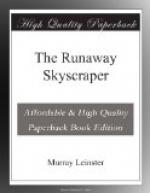She found herself trembling from some undefined cause. Arthur glanced at her. He saw the trembling and knew she would have a fit of nerves in a moment if something did not come up demanding instant attention.
“We’d better take a look at this village,” he said in an off-hand voice. “We can probably find out how long ago it is from the weapons and so on.”
He grasped her arm firmly and led her in the direction of the tents. The other people, left behind, displayed their emotions in different ways. Two or three of them—women—sat frankly down on the steps and indulged in tears of bewilderment, fright and relief in a peculiar combination defying analysis. Two or three of the men swore, in shaken voices.
Meantime, the elevators inside the building were rushing and clanging, and the hall filled with a white-faced mob, desperately anxious to find out what had happened and why. The people poured out of the door and stared about blankly. There was a peculiar expression of doubt on every one of their faces. Each one was asking himself if he were awake, and having proved that by pinches, openly administered, the next query was whether they had gone mad.
Arthur led Estelle cautiously among the tents.
The village contained about a dozen wigwams. Most of them were made of strips of birch-bark, cleverly overlapping each other, the seams cemented with gum. All had hide flaps for doors, and one or two were built almost entirely of hides, sewed together with strips of sinew.
Arthur made only a cursory examination of the village. His principal motive in taking Estelle there was to give her some mental occupation to ward off the reaction from the excitement of the cataclysm.
He looked into one or two of the tents and found merely couches of hides, with minor domestic utensils scattered about. He brought from one tent a bow and quiver of arrows. The workmanship was good, but very evidently the maker had no knowledge of metal tools.
Arthur’s acquaintance with archeological subjects was very slight, but he observed that the arrow-heads were chipped, and not rubbed smooth. They were attached to the shafts with strips of gut or tendon.
Arthur was still pursuing his investigation when a sob from Estelle made him stop and look at her.
“Oh, what are we going to do?” she asked tearfully. “What are we going to do? Where are we?”
“You mean, when are we,” Arthur corrected with a grim smile. “I don’t know. Way back before the discovery of America, though. You can see in everything in the village that there isn’t a trace of European civilization. I suspect that we are several thousand years back. I can’t tell, of course, but this pottery makes me think so. See this bowl?”
He pointed to a bowl of red clay lying on the ground before one of the wigwams.
“If you’ll look, you’ll see that it isn’t really pottery at all. It’s a basket that was woven of reeds and then smeared with clay to make it fire-resisting. The people who made that didn’t know about baking clay to make it stay put. When America was discovered nearly all the tribes knew something about pottery.”




